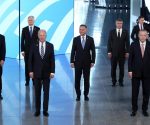Trump turns his ‘maximum pressure’ campaign on Iraq
[ad_1]

“President Trump and those of us in his national security team are reestablishing deterrence, real deterrence, against the Islamic Republic of Iran,” said Secretary of State Mike Pompeo in January. “Your adversary must understand not only that you have the capacity to impose cost but that you’re in fact willing to do so.”
But “deterrence” of any meaningful form does not seem to have been “reestablished.” Instead, U.S. officials are so exasperated with the enduring influence and brazen actions of pro-Iran proxy forces in Iraq that they are threatening a full withdrawal from the American embassy in Baghdad. In September alone, Shiite militias linked to Tehran have carried out more than two dozen attacks in the Iraqi capital or its vicinity, including strikes on U.S. and coalition forces. The escalation is part of an extended response to Soleimani’s killing.
“Two U.S. servicemen, a Briton and several members of Iraq’s security forces have been killed this year in rocket attacks attributed to the militias,” my colleagues reported. “In recent months, small-scale bomb attacks have also targeted convoys linked to the U.S.-led coalition. Iraqi drivers are the focus, which has sown fear among their ranks. A bomb was planted next to a convoy from the British Embassy in Baghdad this month, suggesting a possible new phase in the militias’ campaign.”
The United States pulling diplomats out of the embassy — Washington’s biggest and most fortified mission overseas — may be possibly followed by an aggressive U.S. air campaign against militias in Iraq. Pompeo may hope that the prospect of such action will compel a fragile Iraqi government to take tougher measures against the militias on their own. “Pompeo’s demand creates a stark dilemma for Iraq’s new prime minister, Mustafa al-Kadhimi, who until now had been a Trump administration favorite. The Iraqi leader wants to curb Iran’s proxy forces, but not at the cost of committing political suicide,” wrote Post columnist David Ignatius, referring to the complexity of Iraq’s multi-sect politics. “If Pompeo follows through and closes the embassy to protect Americans, Iran and its allies might claim a major propaganda victory; but the closure could also be a prelude to heavy U.S. airstrikes against the militias.”
Iraqi officials want the Trump administration to change its mind. “We hope the American administration will reconsider it,” Ahmed Mulla Talal, a spokesman for Kadhimi, told my colleagues over the weekend. “There are outlaw groups that try to shake this relationship, and closing the embassy would send a negative message to them.”
The irony of the current moment, though, is inescapable. Since ordering the operation to take out Soleimani and a key allied Iraqi militia commander, the Trump administration has been largely unable to neutralize the scale of Iranian influence in its neighbor. Its recent decision to considerably draw down the U.S.’s deployed forces in Iraq is part of the White House’s stated desire to end America’s “endless wars” in the Middle East, a change in posture that has broad popular support.
Analysts counter that Trump’s aggressive approach to Iran has only raised the likelihood of deeper hostilities. And they suggest that withdrawing the U.S.’s diplomatic mission would enfeeble Washington’s political interests in Iraq. “We would be giving the Iranians more than they ever dreamed of,” a former U.S. official told the Wall Street Journal. “This has been their major strategic goal: To get us out of Iraq.”
There’s also the reality that Iran doesn’t fully control the Shiite militias currently in the U.S.’s crosshairs. “Iran wants to boot the Americans out, but not at any cost. It doesn’t want instability on its western border,” a senior Iraqi Shiite leader told Reuters. “Just like there are hawks in the U.S., there are hawks in Iran who have contact with the groups carrying out attacks, who aren’t necessarily following state policy.”
The Trump administration’s “maximum pressure” campaign has weakened Iran economically. But it has hardly dissuaded Tehran from pushing its own agendas around the region, including its deep role in conflicts and crises in Syria, Lebanon and Yemen.
“Maximum pressure has done nothing to push Iran into abandoning this behavior and is pushing Tehran into doubling down on its investment in these relationships,” wrote Daniel DePetris, a fellow at the think tank Defense Priorities. “The Iranians have sent a signal to the U.S. that pressure will beget resistance. As long as U.S. ground forces remain in Iraq and Syria with an open-ended counter-Iran mission, U.S. servicemembers will be tempting targets for Iranian retaliation.”
But Biden may find it difficult to change course should he end up in the White House. The Trump administration has taken a hammer to the Iran nuclear deal, is hellbent on slapping even more sanctions on Tehran (much to the chagrin of some of the U.S.’s closest allies) and has raised the stakes for future efforts to bring the Iranian regime to the table.
“The Trump Administration and its supporters in Congress believe that now is the time to place even greater pressure on Iran,” wrote Marcus Montgomery of the Arab Center Washington. “Their goal is to sully U.S.-Iranian relations so badly that a potential Joe Biden administration would not be able to negotiate any kind of deal that might benefit Tehran economically and diplomatically.”
Meanwhile, in Tehran’s pseudo-democratic political structure, “reformist” politicians who championed outreach to the West half a decade ago could find themselves wholly sidelined ahead of elections next year. If Biden “wins the U.S. election and returns to the [nuclear deal] swiftly, that will create a limited glimmer of hope in people to vote for a pro-Western candidate,” wrote Iranian analyst Rohollah Faghihi. “However, this will be very difficult as Iranians have vehemently lost trust and believe that at least for now, reformists aren’t able and aren’t allowed to bring up positive changes in the country.”
[ad_2]
Source link









